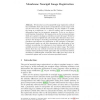Free Online Productivity Tools
i2Speak
i2Symbol
i2OCR
iTex2Img
iWeb2Print
iWeb2Shot
i2Type
iPdf2Split
iPdf2Merge
i2Bopomofo
i2Arabic
i2Style
i2Image
i2PDF
iLatex2Rtf
Sci2ools
ECCV
2010
Springer
2010
Springer
Membrane Nonrigid Image Registration
We introduce a novel nonrigid 2D image registration method that establishes dense and accurate correspondences across images without the need of any manual intervention. Our key insight is to model the image as a membrane, i.e., a thin 3D surface, and to constrain its deformation based on its geometric properties. To do so, we derive a novel Bayesian formulation. We impose priors on the moving membrane which act to preserve its shape as it deforms to meet the target. We derive these as curvature weighted first and second order derivatives that correspond to the changes in stretching and bending potential energies of the membrane and estimate the registration as the maximum a posteriori. Experimental results on real data demonstrate the effectiveness of our method, in particular, its robustness to local minima and its ability to establish accurate correspondences across the entire image. The results clearly show that our method overcomes the shortcomings of previous intensity-based and ...
Related Content
| Added | 06 Dec 2010 |
| Updated | 06 Dec 2010 |
| Type | Conference |
| Year | 2010 |
| Where | ECCV |
| Authors | Geoffrey Oxholm, Ko Nishino |
Comments (0)

